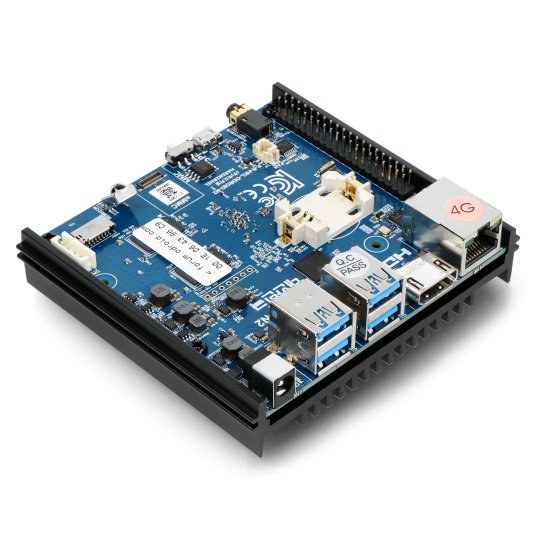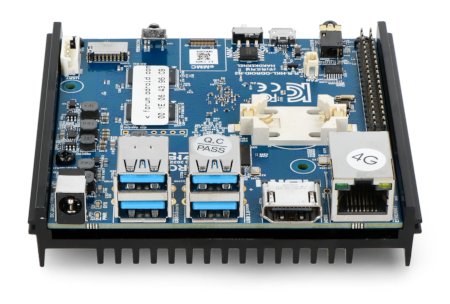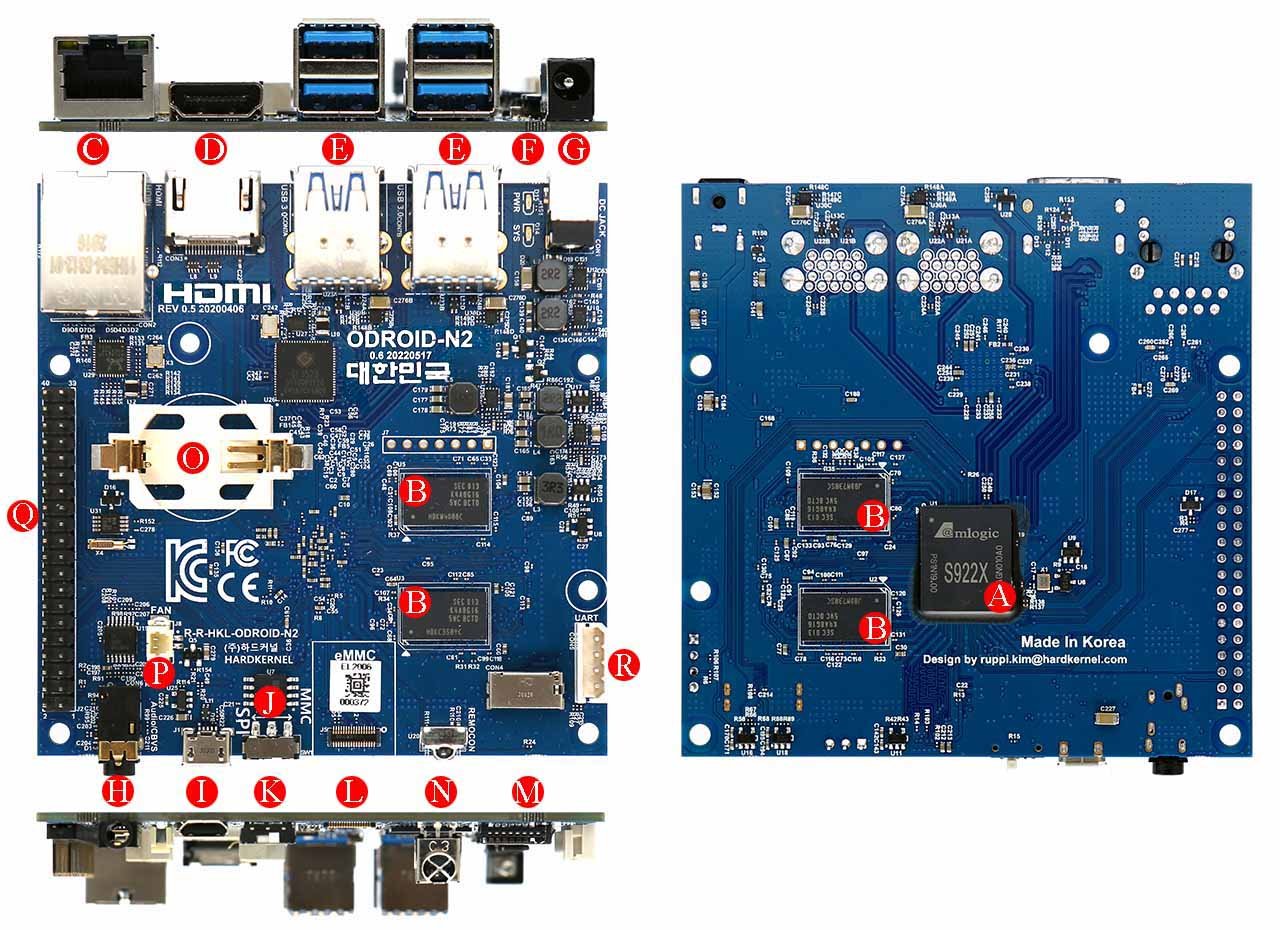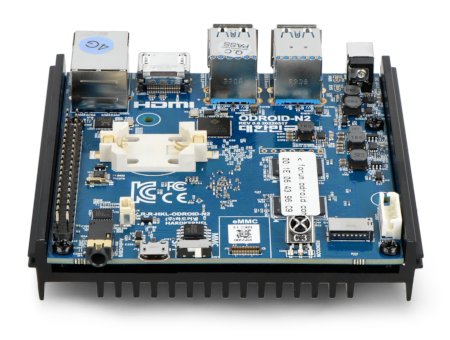Description: Odroid N2+ - Amlogic S922X Cortex A73 + A53 Hexa-Core 2.4 GHz + 2 GHz + 4 GB RAM
Odroid N2+minicomputer equipped with Amlogic S922X processor with four 2.4 GHz Cortex-A73 cores and two 2 GHz Cortex-A53 cores and Mali-G52 GPU.It has 4 GB of RAM andmicroSD cardslotandeMMC memoryslot. The board features a Gigabit Ethernet port, HDMI, 4 USB 3.0, 3.5 mm jack and 40 GPIO pins with popular interfaces such as UART, SPI, I2C, GPIO. The Odroid N2+ version has a lower heatsink than theOdroid N2version.
|
Odroid N2+ comes in two versions:
|
What do you need to run the Odroid N2+ minicomputer?
- A memory card or eMMC memory- a medium for uploading the operating system to the minicomputer.
- Power supply- with an output voltage of 12 V, performance of 2 A and DC plug 5.5/2.1 mm (plus inside).
- HDMI cable- for displaying video on a monitor or other screen.
- Mouse and keyboard- to navigate the system interface and enter data.
- Internet connection - to download drivers and software updates.
- Additional accessories- e.g. WiFi module, touch screen, SATA module.
Minicomputer Odroid N2+.
Operating system for Odroid N2+
Odroid N2+ minicomputer works with Linux Ubuntu Mate and Ubuntu Minimal, as well as with Android Pie 9.0. Odroid N2+ also supports other systems touseit as a media server, game station or server connected to the network. The disk of the device can be a microSD card or eMMC memory.
|
Ubuntu and Android systems can be downloaded fromthe manufacturer's website. |
The layout of the components on the Odroid N2+ board
| Designation | Description |
|---|---|
| A | S922X processor |
| B | DDR4 memory 4 GB |
| C | Ethernet port RJ45 10/100/1000 Mb/s |
| D | HDMI port |
| E | USB 3.0 ports |
| F | LEDs |
| G | DC power connector 5.5 / 2.1 mm |
| H | AV jack output 3.5 mm |
| I | MicroUSB OTG port |
| J | SPI Flash memory 8 MB |
| K | Boot switch SPI |
| L | eMMC Memory Connector |
| M | MicroSD slot |
| N | IR Receiver |
| O | RTC battery socket |
| P | 2-pin connector for fan connection |
| Q | 40 pins GPIO |
| R | UART connector for debugging |
Power supply for Odroid N2+ minicomputer
The device is equipped with a5.5 / 2.1 mmDC jacksocket. The minicomputer can be powered from 7.5 V to 16 V, but the manufacturer recommends12Vand a minimum capacity of 2A.You will find a suitablepower supplyinour offer.
Minicomputer Odroid N2+.
Specification and comparison of Odroid modules
| Basic information | |||||
|---|---|---|---|---|---|
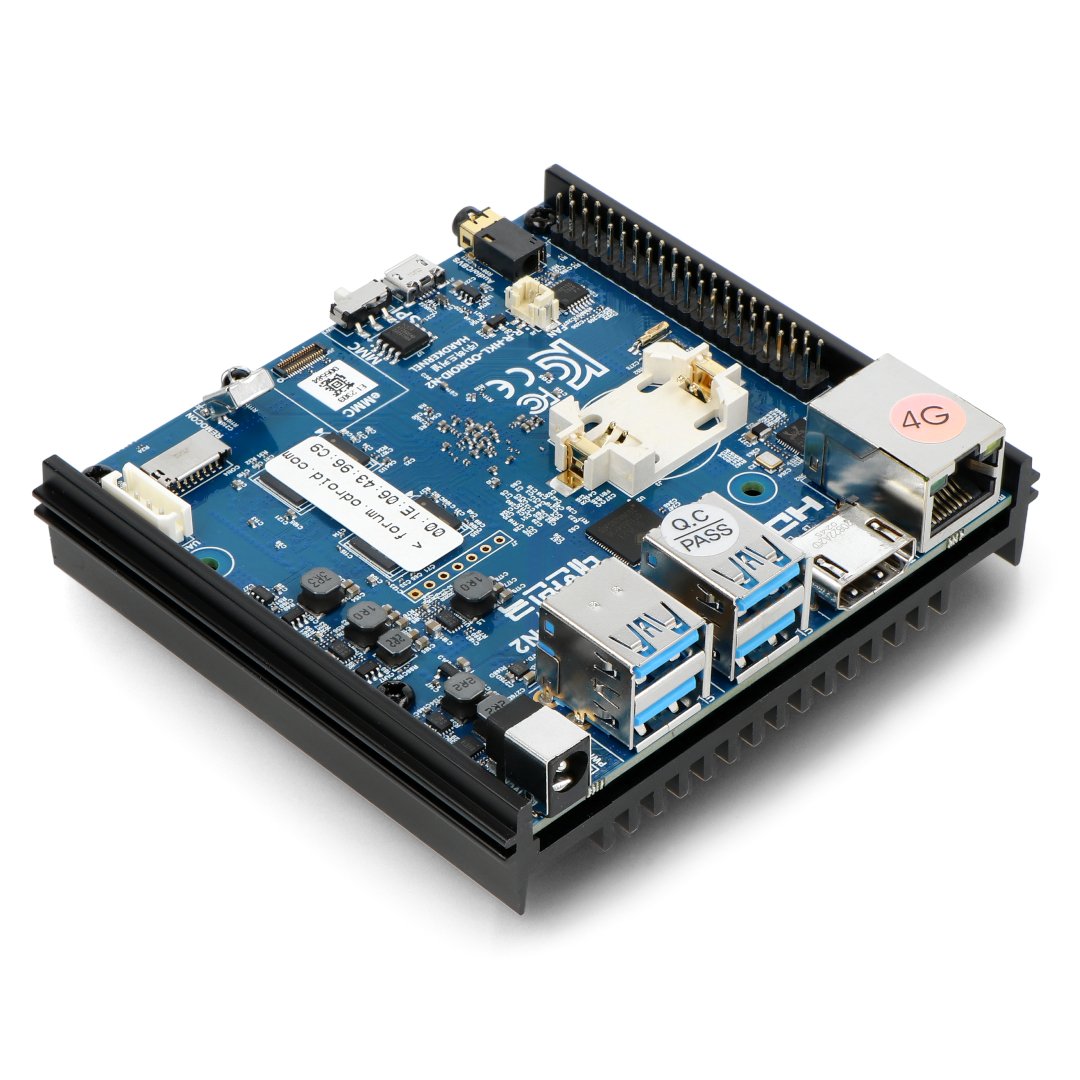 |
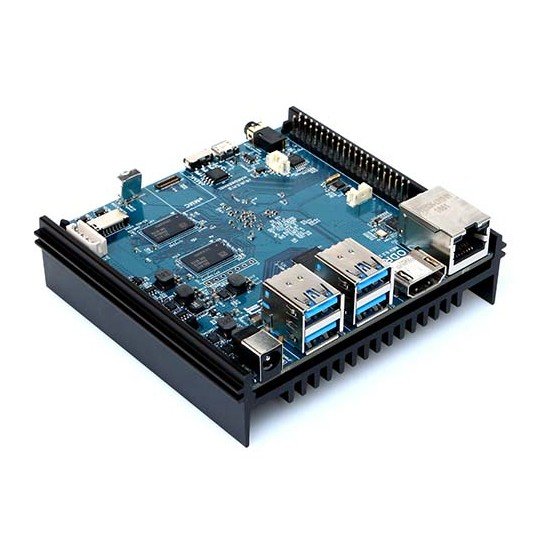 |
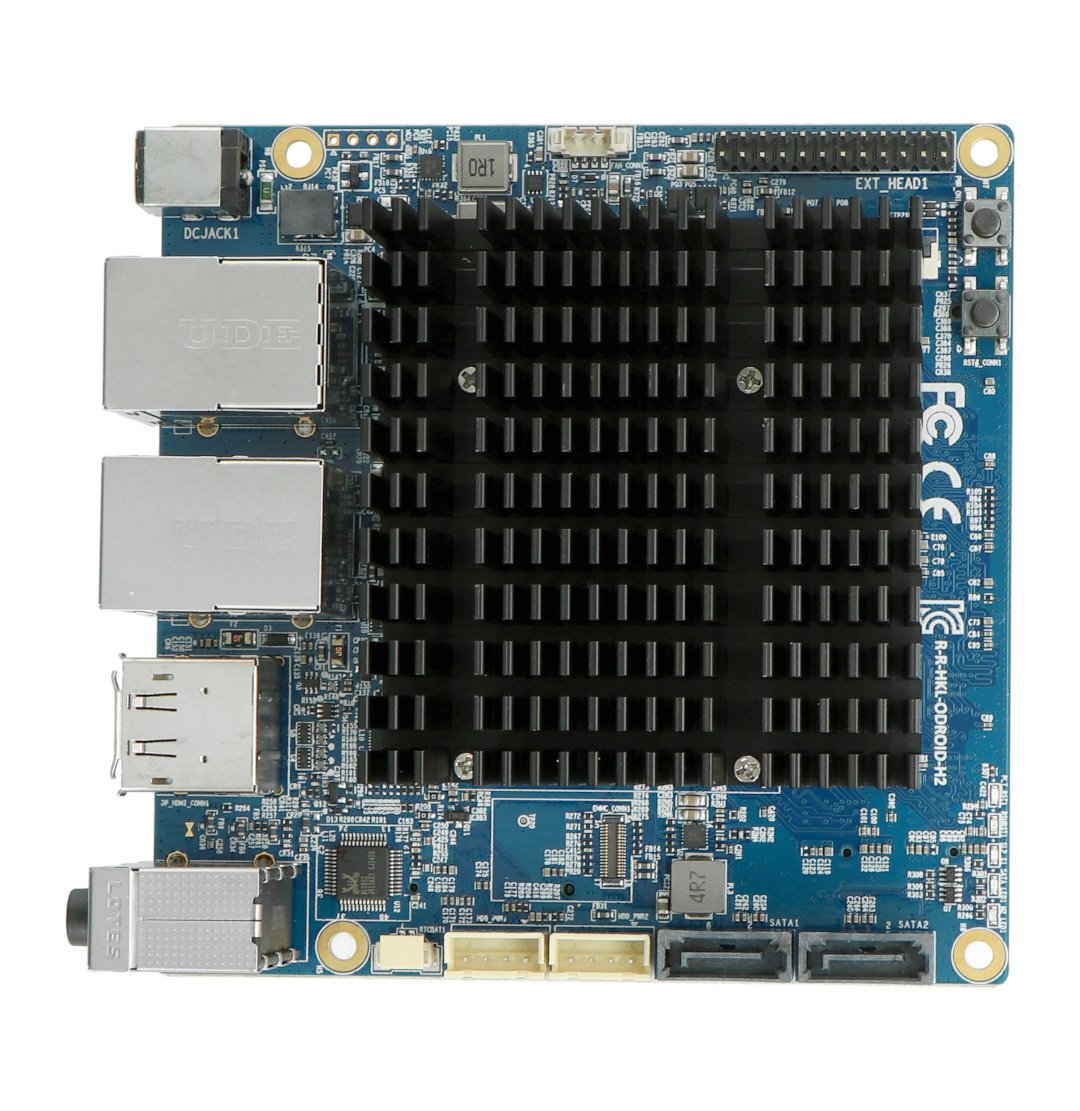 |
 |
 |
|
| Model | Odroid N2+ | Odroid N2 | Odroid H2+ | Odroid C2 | Odroid XU4 |
| Specification |
|||||
| Processor | Amlogic S922X | Amlogic S922X | Intel Celeron | Amlogic S905 | Samsung Exynos5422 |
| Core |
Quad-Core ARM Cortex A73 Dual-Core ARM Cortex A53 |
Quad-Core ARM Cortex A73 Dual-Core ARM Cortex A53 |
Quad-core J4115 |
Quad-Core 64-bit ARM Cortex A53 |
Octa-Core ARM Cortex-A15 ARM Cortex™-A7 |
| Graphics |
ARM Mali G52 OpenGL ES 3.2/3.1/3.0/2.0/1.1 |
ARM Mali G52 OpenGL ES 3.2/3.1/3.0/2.0/1.1 |
UHD Graphics 600 Gen 9.5 N N GT1 |
ARM Mali 450MP OpenGL ES 2.0/1.1 |
3D Mali-T628 MP6 OpenGL ES 3.0/2.0/1.1 |
| Systems |
Ubuntu 18.04 Android 9 Kernel 4.9.162 LTS |
Ubuntu 18.04 Android 9 Kernel 4.9.162 LTS |
Ubuntu 18.04 |
Ubuntu 16.04 Android 5.1 Kernel 3.14 LTS |
Ubuntu 15.04 Android 4.4.2 Kernel LTS 3.10 |
| Clocking | 2.4 GHz + 2 GHz | 1.8 GHz + 1.9 GHz | 2.5 GHz | 1.5 GHz | 2 GHz / 1.4 GHz |
| Architecture | ARMv8 | ARMv8 |
64-bit Gemini Lake |
ARMv8 | ARMv7 |
| Memory RAM |
4 GB DDR4 SDRAM |
4 GB DDR4 SDRAM |
up to 32 GB DDR SO-DIMM |
2 GB DDR3 792 MHz SDRAM |
2 GB LPDDR3 750 MHz frame |
| Memory |
microSD card UHS1 eMMC |
microSD card UHS1 eMMC |
eMMC SATA PCI-e |
microSD card UHS1 to 128 GB eMMC5.0 |
microSD card UHS1 to 64 GB eMMC5.0 |
| GPIO socket |
40-pin connector |
40-pin connector |
20-pin connector |
40-pin connector + 7 pin I2S |
30-pin connector + 12 pin I2S 2 mm raster |
| Power supply |
7,5 V to 16 V recommended: 12 V / 2 A DC Jack 5.5 / 2.1 mm |
7,5 V to 18 V recommended: 12 V / 2 A DC Jack 5.5 / 2.1 mm |
15 V / 4 A DC Jack 5.5 / 2.1 mm |
5 V / 2 A DC Jack |
5 V / 4 A DC 2.5 x 2.1 mm |
| Dimensions of the tiles |
90 x 90 x 17 mm heat sink: 100 x 91 x 18.75 mm |
90 x 90 x 17 mm radiator: 100 x 91 x 24 mm |
110 x 110 x 47 mm | 85 x 56 x 18 mm | 82 x 58 x 22 mm |
| Interfaces | |||||
| USB Host |
4 x USB 3.0 |
4 x USB 3.0 |
2 x USB 3.0 2x USB 3.0 |
4x USB 2.0 socket type A |
2x USB 3.0 1x USB 2.0 socket type A |
| USB OTG | 1x microUSB |
1x microUSB |
- | 1x microUSB | - |
| Network interface |
10/100/1000 Mbit/s |
10/100/1000 Mbit/s |
10/100/1000/2500 Mbit/s |
10/100/1000 Mbit/s |
10/100/1000 Mbit/s |
| RTC system | Built-in | Built-in | Built-in | - | - |
| Video |
HDMI Composite Video SPDIF (optional) |
HDMI Composite Video SPDIF (optional) |
HDMI 2.0 DisplayPort 1.2 4K@60 Hz |
HDMI 2.0 4K/60Hz | HDMI 1.4a |
| Audio |
HDMI / Audio OUT |
HDMI / Audio OUT |
Jack 3.5 mm SPDIF |
HDMI / I2S |
HDMI |
| ADC transmitter |
2 channels 10-bit |
2 channels 10-bit |
- |
2 channels 10-bit |
2 channels 10-bit |
| Communication |
UART, SLEEPING, I2C, GPIO, ADC |
UART, SLEEPING, I2C, GPIO, ADC |
UART, I2C, GPIO - 3.3 V |
UART, SLEEPING, I2C, GPIO, ADC |
UART, SLEEPING, I2C, GPIO, ADC |
Useful links |
